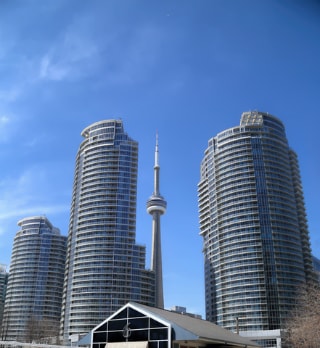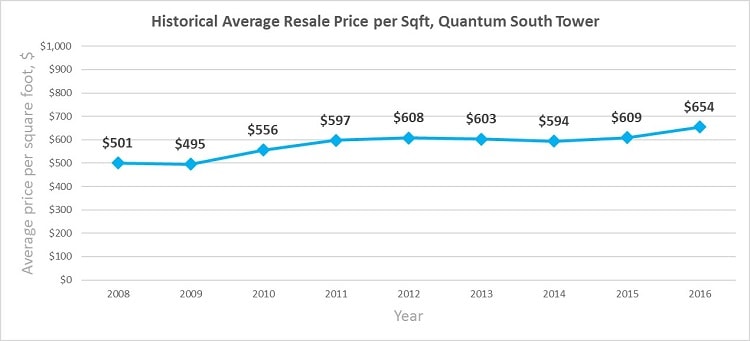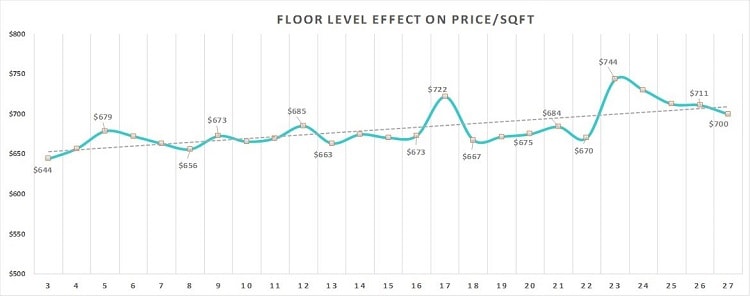Get a free Condo Insurance quote and start saving today!
One of the questions asked a lot by buyers looking at investment condos for sale in Toronto – typically pre-construction condos – is whether or not they should pay more to buy a unit on a higher floor since many end customers really enjoy great views from higher floors.
That’s why our friends at Condos.ca – the GTA’s most comprehensive condominium guide – have shared their study.
It’s a question that’s not only critical to real estate investors but end-user buyers as well, since return on investment should be a top priority, regardless of whether a buyer is purchasing the unit as an income property or as a home to move into.
So, should you move up to make more?
Is the Condo Investment Opportunity Better, the Higher Up You Go?
It’s common practice for builders to charge a floor premium, typically around $2,000 extra per floor, for the same unit higher up. For example, the same model/floor plan on the 15th floor could be $20,000 more than the 5th floor.
High floors are often associated with beautiful, breath-taking views – see an example on the right (e.g. views from Westlake condo in Etobicoke).
The question is, is the return on your investment going to be higher, the higher up you go?
Firstly, I want to address the reason nobody in the industry is answering this question straight up. There is no perfect sample building where you’ll find identical units, in the same condition on every level, each with a re-sale at the same point in time.
Without that, it’s difficult to compare return on investment across multiple units. But we can get a fairly accurate picture of what’s going on by getting a little creative. Here is how we did it…
We took a sample of seven condo buildings* in the Yonge & Eglinton neighbourhood and analyzed all sold data from MLS sales in each, from 2004 to 2016.
For each building, we adjusted every past sales price to its net present value. Specifically, the net present value of each unit was calculated by multiplying its historical sales price by an increase factor; that increase factor was based on historical trends of that building from Condos.ca data – as you know, Condos.ca has extensive trends data on thousands of condo buildings in Toronto and surrounding areas that track average price per square foot.
Here’s an example of our proprietary historical trends data for Quantum South Tower, one of the condo buildings in this study.
It may NOT Pay to Buy Up
Our analysis revealed a distinct pattern across all buildings. Condo sales prices do increase as the floor level increases but to a smaller degree than investors may realize. Below is a sample chart illustrating the 70 Roehampton’s cost per sqft as it relates to floor level; you’ll see it’s not a straight trajectory as some investors may think. A higher floor level is not a guarantee of a higher re-sale price.
Combining the results of all seven buildings we could see the average % change per floor and then preform a regression, which is illustrated in the chart below.
In a nutshell, price changes between floors netted out in the -6% to +3.5% range across floors three through thirty. A +0.35% sales price increase per floor is about what you can expect in re-sale. That’s the figure you should keep in mind when calculating whether or not the floor premium in an asking price is worth it or not.
Recommendation: 0.35% is the magic number
Get a free Condo Insurance quote and start saving today!
So, next time you are considering investing in a pre-construction condo, if the views are the same and the developer’s floor premium equates to more than+ 0.35% of the sale price, you may want to think twice. If it’s less than a 0.35% premium, move on up!
It means that for example for a condo you re buying for $400,000 a price increase per floor should not be higher than $1,400 = 0.35% * $400,000
Today’s guest post is by Carl Langschmidt of Condos.ca. Condos.ca is the GTA’s most comprehensive condominium guide where users can search for condos for sale in Toronto and surrounding areas, connect with our Condo PROs and find exclusive price trends data for individual buildings and neighbourhoods to ensure that your condo purchase is a wise investment. Also, don’t forget to protect your new condo through homeowners insurance for condo.
* Data based on historical sales at: 2181 Yonge, 2191 Yonge, 25 Broadview, 70 Roehampton, 83 Redpath, 88 Broadway and 212 Eglinton.





John Howland
November 2, 2016 at 5:07 pmThe top floor is best because you won’t hear noises from the unit above.
I’m on the 4th floor of a 6 floor steel and concrete building built in 2008. The IIC measurement is 6.0 but I still hear footfall, vacuum cleaning and a bubble wrap popping sound when people walk on the carpets. The footfall in certain areas is just as loud as a heavy-footed person walking behind you. One night I thought I was having a home invasion. Turned out it was the neighbor above me coming home. There is no STC noise.